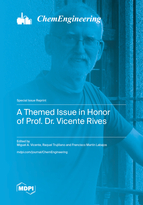A Themed Issue in Honor of Prof. Dr. Vicente Rives
A special issue of ChemEngineering (ISSN 2305-7084).
Deadline for manuscript submissions: closed (30 June 2023) | Viewed by 43653
Special Issue Editors
Interests: clay-based materials; preparation, characterization, and catalytic activity of metal supported nanocatalysts; surface properties of solids; pollutants adsorption; environmental management
Special Issues, Collections and Topics in MDPI journals
Interests: layered double hydroxides; clay materials; microwave-assisted preparation of materials; photocatalysis
Special Issue Information
Dear Colleagues,
Our journal is pleased to publish a Special Issue in honor of Professor Vicente Rives on his retirement. After graduating with a Ph.D. in Chemistry at the University of Seville, Prof. Rives has worked at the University of Salamanca for forty years. Aside from years of very fruitful teaching and management activities, Prof. Rives has developed intense research activity, with outstanding contributions to different topics of inorganic chemistry, solid state chemistry, chemistry of materials, and other disciplines. Prof. Rives has been the Editor for articles on clay minerals, thermochimica acta and applied clay science, and has also edited Special Issues for different Journals (i.e.: https://0-www-mdpi-com.brum.beds.ac.uk/journal/ChemEngineering/special_issues/Layered_Hydroxides). Although his research has been mainly focused to the study of Layered Double Hydroxides (LDH), Prof. Rives has also developed intense research on metal oxides, clay minerals, catalysis and photocatalysis, thermal analysis, and other subjects, such as chemical aspects of Cultural Heritage conservation.
Prof. Dr. Miguel A. Vicente
Prof. Dr. Raquel Trujillano
Prof. Dr. Francisco Martín Labajos
Guest Editors
Manuscript Submission Information
Manuscripts should be submitted online at www.mdpi.com by registering and logging in to this website. Once you are registered, click here to go to the submission form. Manuscripts can be submitted until the deadline. All submissions that pass pre-check are peer-reviewed. Accepted papers will be published continuously in the journal (as soon as accepted) and will be listed together on the special issue website. Research articles, review articles as well as short communications are invited. For planned papers, a title and short abstract (about 100 words) can be sent to the Editorial Office for announcement on this website.
Submitted manuscripts should not have been published previously, nor be under consideration for publication elsewhere (except conference proceedings papers). All manuscripts are thoroughly refereed through a single-blind peer-review process. A guide for authors and other relevant information for submission of manuscripts is available on the Instructions for Authors page. ChemEngineering is an international peer-reviewed open access semimonthly journal published by MDPI.
Please visit the Instructions for Authors page before submitting a manuscript. The Article Processing Charge (APC) for publication in this open access journal is 1600 CHF (Swiss Francs). Submitted papers should be well formatted and use good English. Authors may use MDPI's English editing service prior to publication or during author revisions.
Keywords
- layered double hydroxides
- mixed oxides
- clay materials
- catalysis
- photocatalysis








